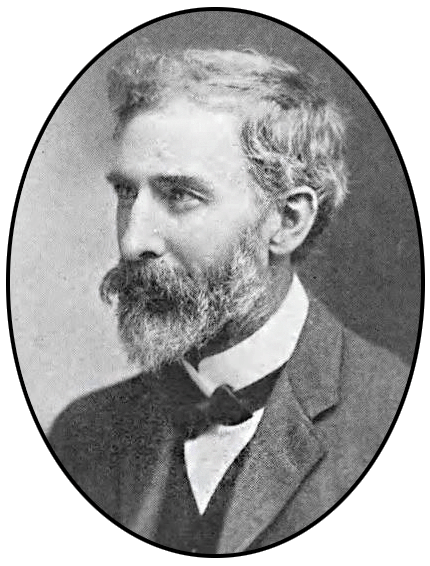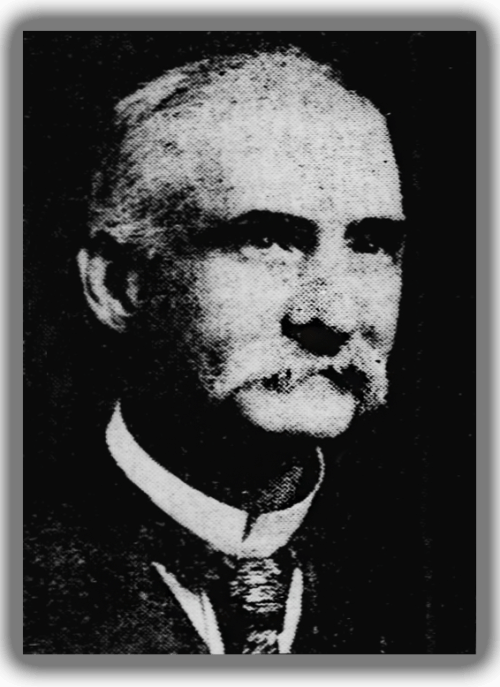Mayor of Norwich (1900-1908) & (1910-1912)
Charles Frederick Thayer (b.1852-d.1915)
At the end of the 19th century a relatively new idea was being celebrated, labeled as “Old Home Week“. In 1901 Norwich officials started committees and activities for an Old Home Week in the Rose City. Within one month the city was ready to present its version of Old Home Week. The idea and the necessary actions to move the project forward are credited to Mayor Charles F. Thayer.
On September 1-7, 1901 Norwich celebrated Old Home Week in a grand fashion.

on Washington Street
”Many private residences in every part of the city, were patriotically decorated in honor of the festive period, but none of them excelled the commodious home of Mayor Thayer on Washington Street, where the mayor and Mrs. Thayer dispensed the most cordial hospitality. The house was resplendent with incandescent lamps, 35 of them surrounding a shield on the front of the house bearing a design of twin roses, the emblem of the city. Mayor and Mrs. Thayer kept open house all the week, receiving their guests in the spacious front hall, which was brilliantly lighted with 102 incandescents, producing a very beautiful and artistic effect.”
(From Info Source 1)

Mr. Thayer studied law in Norwich with his older brother, John M. Thayer, for 3 years and was admitted to the bar in June, 1881. While working in his brother’s law office, he recorded the proceedings of several celebrated murder trials. These experiences helped him became an expert in the field of stenography. He was one of the first to introduce stenography into the courts of Connecticut and to obtain legislation requiring official stenographers therein.
Charles Thayer was always a Democrat. He began his political career in 1891, when he was elected to the State Senate from the Norwich District. In that election he succeeded a republican and served prominently. He was the Democrat candidate for Governor of the state of Connecticut in 1906.
He later became a New London County Health Official, the New London County Treasurer, and a Judge of the Superior Court. He was also a Freemason and a member of the Independent Order of Odd Fellows.
Charles Thayer was also a driving force behind the 250th Celebration of the Anniversary of Norwich. While he was mayor, on February 3, 1908, he appointed an oversight committee for all the other anniversary committees. The celebration, one Norwich’s grandest, took place on July 4-6, 1909.
He is buried along with his wife Mary Hewitt Thayer in Maplewood Cemetery.
Acknowledgements
“Old Home Week, Norwich, Conn., September 1-7 1901,” (1901), p 13
Norwich Bulletin (07/12/1915)
The complete list of sources may be found by clicking the “Bibliography” button, and, then typing “Thayer” in the SEARCH box.
Mayor of Norwich (1908-1910)
Costello Lippitt (b.1842-d.1924)
Costello Lippitt, the Mayor of Norwich from 1908-1910, was a distinguished banker and financier.
He did not pursue public office until well into his sixties. In early 1908 he ran for Mayor of Norwich and in June of that year, he defeated longtime Democratic mayor Charles Thayer in a close race, with a “majority of only 75”. In his 1910 bid for Mayor, he was succeeded by the man whom he had bested in 1908, Charles Thayer.
In November 1910 Lippitt won the election for the State Treasurer of Connecticut by defeating the Democratic nominee, Edward T. Brown. He served as Treasurer through 1913.
The majority of Lippitt’s business career was spent as a banker. He was actively involved with the Thames National Bank, the Norwich Savings Bank, the Norwich Savings Society, and was the President of the Merchants National Bank. He was also a director of the Norwich Street Railway Company (a.k.a. the trolley system), and he was on the board of the Norwich Fee Academy, the Eliza Huntington Memorial Home, and was the first President of the Board of Trustees for the Norwich Hospital for the Insane.
Like several other of Norwich’s previous Mayors, Costello Lippitt was a Freemason. He was a 33rd degree Master Mason in the Somerset Lodge No. 34. He became an Eminent Commander of the Columbian Commandery No. 4, Knights Templar, was a Past Grand Commander for Connecticut in 1892. Beginning in 1892, he was the Treasurer for the Masonic Temple Corporation. In 1894, the Corporation erected the first building in the world that was used specifically for Masonry. The Masonic Temple was built across the street from the Norwich City Hall / Court House.
In August 1864 Costello Lippitt married Emily Hyde Standish, to whom he was wed until her death in 1889. Following his wife’s death, Lippitt married Gertrude Hopkins Lamphere, whom he also survived. He and both of his wives are buried in the Yantic Cemetery.
Acknowledgements
Strangest Names in American Political HIstory
Norwich Evening Record, (1894), p 33
The complete list of sources may be found by clicking the “Bibliography” button, and, then typing “Lippitt” in the SEARCH box.

Mayor of Norwich (1912-1916)
Timothy C. Murphy (b.1859-d.1937)
Mayor T. C. Murphy worked hard to develop business in both Norwich and Southeastern Connecticut. He was a member of the Norwich Business Men’s Association that was created to encourage the development of Southeastern Connecticut. Throughout his term as mayor he encouraged collaboration and business development in Norwich.
On July 24, 1912, soon after he took office, he led a businessmen’s get-together outing. The outing, at Kitemaug on the Thames, was attended by 250 leaders of Norwich, New London, Willimantic, and Putnum. The featured attraction was a baseball game between Norwich and New London leaders. The Captain of the Norwich team was T. C. Murphy. And, yes, he scored the first run. Norwich won the game; New London did not score any runs.
After the game, Mayor Murphy addressed the crowd. Here’s an excerpt from his speech from Source 1:
“What should business men do to help their own cities or towns? They should always take great interest in the manufacturing industries of their communities; they should always try and help their own industries with their moral and financial aid. Of course, a city’s prosperity lies mostly with what the people themselves make of it.”
“If there is anything that will hurt our associations, it is a lot of chronic kickers. When you ask them to go down into their pockets to aid a local concern or to take stock in any manufacturing concern that would locate in the town or city, they will always tell you what they lost in such and such concerns. But if some good, slick advance agent of a mining or copper concern comes to see them and offers a gold brick, they will never mention that. If half the money that is spent in bucket shops and outside investments was spent in the local ties where it was made, we should have larger cities and towns than we have today.”
He is buried in Saint Joseph Cemetery, along with his wives Elizabeth M. Flood Murphy and Isabella A. Flood Murphy.
Acknowledgements
Norwich Bulletin (07/24/1912)
“The Celebration of the Two Hundred and Fiftieth Anniversary of the Settlement of the Town of Norwich, Ct and of the Incorporation of the City, the One Hundred and Twenty-Fifth, July 4-6, 1909,” (1912), p 24, by William C. Gilman
The complete list of sources may be found by clicking the “Bibliography” button, and, then typing “Murphy” in the SEARCH box.
Mayor of Norwich (1916-1918)
Allyn Larrabee Brown (b.1883-d.1973)
At 32 years old, Allyn L. Brown became the youngest man, at that point-in-time to be elected as the Mayor of Norwich. He was a successful lawyer, a judge on the Superior Court, and later became the Chief Justice of the Connecticut Supreme Court.
After graduating from the Norwich Free Academy, he continued his education at Brown University, and then graduated from the Harvard Law School in 1908. After being admitted to the bar in 1909, he joined his father’s law firm, Brown & Perkins. In 1917 Mr. Brown became the first public defender in New London County.
He was the Mayor of Norwich during a turbulent period of United State history. Throughout his tenure as mayor the United States was immersed in World War I (July 1914-Nov 1918). After the war was over Norwich celebrated her 1600 soldiers returning home and Allyn L. Brown was the Chairman of the Reception Committee. He managed the committee, which was comprised of approximately 20 sub-committees, and sent out invitations to many prominent public figures to honor the day.
The celebration was held at the New London County Fairgrounds (near present-day Three Rivers Community College in Norwich). The celebration of September 20, 1919 was a glorious event!
He is buried in Yantic Cemetery along with his wife Marion Brown.
Acknowledgements
Wikipedia
Norwich Bulletin (09/19/1919)
Norwich Bulletin (05/13/1916)
The complete list of sources may be found by clicking the “Bibliography” button, and, then typing “Allyn L Brown” in the SEARCH box.

Mayor of Norwich (1918-1920)
Jeremiah Joseph Desmond (b.1856-d.1926)
J. J. Desmond was one of the most eminent attorneys in New London County in the early 1900’s. He served Norwich in many ways. He first moved to Norwich at the age of 22 after graduating from the Holy Cross College in Worcester, Massachusetts. He completed his formal education at the Columbia Law School, in New York City, and was admitted to the bar in 1880.
Mr. Desmond was blessed with strong family roots. His parents, who were Irish farmers, immigrated to Boston. His father took a job as a bookkeeper for a company who built railways in Southeastern Connecticut.

After several years working on a large contract for the development of a railroad between Willimantic and Baltic, he bought and operated and operated two farms. J. J. Desmond grew up in a hard working, family atmosphere.
Before serving as Mayor of Norwich, he was the Secretary of the Greeneville School Board for eight years and was on the School Board of the Central District for several years. He was a member of the Catholic Benevolent Legion, the Foresters of America, and the White Cross Council No. 13 Knights of Columbus. In 1921 he was the New London County Coroner. He and his family were devout members of the Roman Catholic Church.
During World War I, (1914-1918), many Norwich citizens contributed to the war effort by buying and pledging to buy War Savings Stamps. The money raised from the sale of these stamps was used to help the U.S. Government to pay for the war effort. After the war was over in November 1918, the government still needed money help pay the continued U. S. military presence in Europe.
Mayor J. J. Desmond strongly supported this fund raising effort. On December 13, 1918, a month after the war ended, he issued a “War Savings Proclamation”.
His proclamation stated : (from Info Source 2)
”Therefore, I, J. J. Desmond, as mayor of Norwich do hereby call upon the patriotic men, women and children of Norwich to make good their war savings pledges: and upon all to buy as many war savings stamps as they can, and thus rally to the support of our nation, so that America’s great task can be finished.”
On the day this proclamation was issued the sales of stamps were reported to be the best day yet. It was reported that sales, in good amounts, were coming in all day at the Thayer building headquarters.
Mr. Desmond married his first wife, Marguerite A. Cunningham, in June 1896. After she died, in 1906, he married Catherine C. Somers in 1911.
J. J. Desmond is buried in Saint Joseph Cemetery along with his second wife Catherine C. Somers Desmond.
Acknowledgements
“A Modern History of New London County Connecticut, Vol. 2,” (1922), p 98, by Benjamin Tinkham Marshall
Norwich Bulletin (09/19/1919)
“The Celebration of the Two Hundred and Fiftieth Anniversary of the Settlement of the Town of Norwich, Ct and of the Incorporation of the City, the One Hundred and Twenty-Fifth, July 4-6, 1909”, (1912), page n21, by William C. Gilman
Wikipedia
The complete list of sources may be found by clicking the “Bibliography” button, and, then typing “Desmond” in the SEARCH box.
Mayor of Norwich (1920-1922)
Herbert Morgan Lerou (b.1871-d.1959)
Herbert Lerou was an unusually skilled pharmacist who had a deep and abiding interest in all that concerned public welfare. He was the Mayor of Norwich from 1920 thru 1920. However … he won the June 7, 1920 election by only 1 vote. It was closest mayoral election in all of Norwich’s history.
He always embraced the principles of the Republican party, and prior to his becoming mayor he was elected to the Common Council. He was subsequently elected as Registrar and to the City Board of Education. He was an incorporator of the Chelsea Savings Bank, a Trustee of the Maplewood Cemetery, and the President of the Connecticut State Pharmaceutical Association.
Mr. Lerou was quite active within fraternal orders. He was a member and Treasurer of Somerset Lodge, No. 34, Free and Accepted Masons; Frana member of the klin Chapter, Royal Arch Masons; Franklin Council, Royal and Select Masters; Columbian Commandery, Knights Templar; and in the Ancient and Accepted Scottish Rite.
He held the degrees of King Solomon Lodge of Perfection, Van Rensselaer Council of the Princes of Jerusalem, Norwich Chapter of Rose Croix, and the Connecticut Consistory, Sublime Princes of the Royal Secret. He was a Noble of the Sphinx Temple, Ancient Order of the Mystic Shrine.
Mr. Lerou married Bertha B. Carroll in 1895, but unfortunately, she died seven years later in 1902. Subsequently, in 1908, he married Mary S. Tourtelotte. Mr. Lerou is buried in Maplewood Cemetery along with both Bertha and Mary.
Acknowledgements
“A Modern History of New London County Connecticut, Vol. 2,” (1922), pgs 155, 156, by Benjamin Marshall Tinkham
“A Modern History of New London County Connecticut, Vol. 2,” (1922), p 154, by Benjamin Marshall Tinkham
The complete list of sources may be found by clicking the “Bibliography” button, and, then typing “Lerou” in the SEARCH box.
Mayor of Norwich (1922-1928)
Milo Robertson Waters (b.1867-d.1932)
Milo R. Robertson owned and operated a large, progressive printing establishment in Norwich and later became a prominent public official.
He began work at the age of 16 in the Hallville Woolen Mill (present-day Preston Historic District). After 3 years there, he became a printer’s apprentice under the tutelage of Frank Utley in Norwich. Upon completion of his apprenticeship he secured a position with N. B. Hamilton. When the Spanish American War broke out in 1898, Mr. Waters enlisted and served throughout the war with Company C, 3rd Connecticut Regiment of Volunteer Infantry.
Upon returning to Norwich, after an honorable discharge, he opened a small printing business at 265 Main Street. As the business expanded he moved his enterprise to 103 Broadway, where his plant was equipped with every modern device.
Mr. Waters was elected as a Democrat member of the Norwich Common Council in both 1912 and 1914. Later, in 1916, he was elected to the board of Aldermen, and, subsequently elected as Mayor in 1922. He was also a member of the Rotary Club and the Norwich Chamber of Commerce.
He married Rachael Maggs in 1891, but unfortunately she died eight years later in 1899. He later married Myra A. Cochrane in 1905. Milo R. Waters in buried in Nathan Hale Cemetery, Coventry, CT.
Acknowledgements
“A Modern History of New London County Connecticut, Vol. 2,” (1922), p 154, by Benjamin Marshall Tinkham
Find A Grave
The complete list of sources may be found by clicking the “Bibliography” button, and, then typing “Milo” in the SEARCH box.